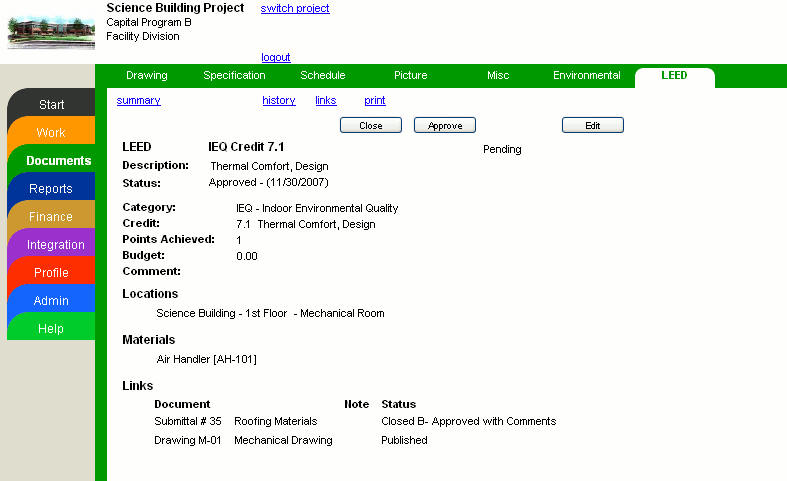August 2009
![]()
AutomatedBuildings.com
[an error occurred while processing this directive]
(Click Message to Learn More)
August 2009 |
[an error occurred while processing this directive] |
|
|

Houston Neal
|
Given the recent deadline for registering LEED v2.2 projects, we were reminded of a post we wanted to write: how construction project management software can be used to track LEED credits.
|
|
|
|
|
|
|
|
|
|
|
|
|
[an error occurred while processing this directive] |
|
|
|
|
|
|
|
|
|
|
|
|
|
|
|
[an error occurred while processing this directive] |
Tracking LEED credits requires software functionality
similar to that required for more traditional construction project management.
Consequently, a few leading vendors have re-purposed their technology to make
this possible; others have customers who have developed their own work-arounds.
We expect to see a lot more software development as the number of annual LEED
projects continues to grow. In the meantime, we’ve researched what’s available,
how it works and how you can benefit from it. Here’s the scoop.
To Start, LEED Requires Strong Document Control
Tracking LEED credits is a document-intensive process. Just ask any
experienced LEED Accredited Professional (AP). Submittal documentation includes
drawings, receipts, product spec sheets, photos, commission plans and more.
Adding to the clutter, numerous project members will access and edit these
documents.
Project management software, especially web-based systems, act as a repository
for the storage and retrieval of critical project documents. Simply upload a
document into the system, then attach it to the appropriate LEED-credit log.
From there you can track the history of a document, see every change that has
been made and who made it.
EADOC is a web-based system that offers LEED
tracking functionality. This example screenshot shows LEED credit details for
Indoor Environmental Air Quality (IEQ) 7.1. The page includes information on
what materials were used, the project location and status of approval. More
importantly, notice the attached submittal and drawing documents. These files
provide a paper trail for proof of compliance.

Tracking Credits with Reports by Category
Here’s another example from
Procore, developers of
web-based construction project management software.
The example below is for Materials and Resources (MR) Credit 2, construction
waste management. This credit requires contractors to recycle and/or salvage 50%
to 75% of nonhazardous construction debris.
![]()
Procore’s LEED detail tracking page includes a brief
description of the credit and a table with the requirements. Users can upload
related documents (in this case a disposal ticket from the waste management
company), then log specific details in each column (weight of material
disposed).
Achieving a Single View of LEED Progress
We spoke with Tooey Courtemanche, CEO of Procore, to understand how his
system allows users to track progress toward LEED qualification. Using his
system, project managers can track credits on a per-project basis. After
selecting which LEED version the project is working toward (e.g. v2.1, v2.2 or
v3), the software returns a dashboard-view of all credits available.
![]()
From here, users can monitor the credits they’re
applying for and the corresponding documents. Clicking on a link takes them to
the detail tracking page for that credit. Submittals can be emailed, faxed or
uploaded into the system, then attached to the credit. This is especially handy
for LEED APs and construction managers that need to log files from the field.
When it comes time to apply, all files will be safe and secure in a single
place. Users can then generate PDFs to submit to the LEED-Online system.
[an error occurred while processing this directive]
Additional Benefits
Aside from the aforementioned benefits, project management software can be
used to schedule and coordinate important project dates (e.g. commissioning
sessions), it can give you a competitive edge to win more LEED projects and it
provides the document tracking required to get AP accreditation.
Finally, project management software mitigates risk. There are big financial
ramifications if you fall from a gold to silver, or off the podium entirely. As
Courtemanche explained to us, “Just as accounting software has become a ’source
of truth’ for financial reporting, project management software is a source of
truth for LEED certification.”
Future Potential
In terms of development, we’re only seeing the tip of the iceberg. There is
great potential for software vendors to create advanced features and
functionality to make LEED tracking a less complicated process. Maybe we’ll even
see a “click to submit” function for companies to submit electronically to the
USGBC.
In the meantime, here are a few of our ideas. Feel free to
send me a comment if you have
other suggestions.
Executive dashboard - Shows up-to-date LEED scorecard and latest project activity
Portfolio roll-up - Ability to look at a “portfolio” view of all past and current LEED projects
Resource database - Share best practices and case studies with other APs and contractors
ROI/IRR Analysis - Calculate internal rate of return for a building based on discounted cash flows and investment costs
Submittal templates - Use templates to generate indoor air quality (IAQ) plans, construction waste management plans, credit interpretation requests (CIR) and other submittals
About the Author
Houston Neal manages the Software Advice blog, a
website with reviews of
web based construction management software. This article was originally
published at:
Track LEED v3 Credits in Project Management Software.
[an error occurred while processing this directive]
[Click Banner To Learn More]
[Home Page] [The Automator] [About] [Subscribe ] [Contact Us]